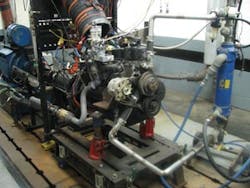Road to Certification
Affordable Fuel Injection Inc. has set out to certify a remanufactured gasoline engine to give GSE fleet managers another option to meet EPA and California compliance standards. Nearing the end of the certification process, it is a project that has been two years in the making.
The Project
The company set out to use a remanufactured Ford 300 gasoline engine to meet upcoming emissions standards. The engine went out of production in 1995, but a stockpile has allowed it to show up in equipment as late as 2001, according to Norman Witte, president of Affordable Fuel Injection. “That engine is no longer built by Ford motor company, however, a lot of equipment still has that engine in it,” he says. “At the industrial level like that it was never a certified engine. It strictly was a carbureted engine that went into off-road and industrial applications.”
The company has fitted the Ford 300 engine with its fuel injection technology to meet emissions standards. The engine also has many remanufactured, or “recycled,” components, which, Witte says, adds to the overall “green” value.
The remanufactured engines were designed by the company to be drop-in engines, using many original parts. “We are using a lot of components that are still commercially available and we haven’t had to create any new add-ons to engines or anything else like that mechanics or are not used to already using.
“Serviceability-wise and from a parts proliferation standpoint, you don’t have a whole plethora of new parts that you would have to stock or be worried about with this engine,” he says. “If somebody wants a certified version of this engine, they can literally pull one and drop another one in and be back in service in a day or two. You’re not tearing the whole vehicle apart to meet emissions standards.”
A minimal amount of new technology has kept the remanufactured engine a low-cost option, according to Witte. “By doing what we have done, we keep the cost down and still allow for compliance,” he says.
Challenges
The project has been no small undertaking, and completion has taken longer than anticipated by the company. “We actually planned on having this done last summer and now we’re just finishing up,” Witte says.
The certification process was a new venture for the company, which has specialized in fuel injection systems for the automotive aftermarket. “We have worked on the development side of the business for years,” he explains. “The actual certification process is new to us, and now we find ourselves doing both.”
The company had also worked toward producing a retrofit kit for the gasoline engines to help GSE fleet owners meet emissions standards set forth by California. The initial plan was to complete the retrofit kit and the engine simultaneously. But complications that delayed the completion of the retrofit kit prompted the company to reconsider its plan.
“An awful lot of customers I was talking to in the California market were going to replace complete engines anyway, so it really made sense to go forward with a certified engine and follow that up later with a retrofit kit,” he says.
A New Strategy
The company focused on certification of the remanufactured engine, running developmental testing in accordance with EPA requirements for a small-volume manufacturer. The company finished developmental testing, and went into the final phase of testing in the beginning of the year. Having completed all the required documentation during the developmental testing phase, certification looked well within reach – until the company was stopped short in its tracks.
“Between the time we had started testing and the time we went to our final testing, the procedure we were testing to had been dropped from the EPA rules,” he says. “We could no longer use the procedure that we had been developing to all along. So we had to work to a different test procedure that we had never even tested to before.”
Persistence Pays Off
The company remained persistent, testing to a new procedure directed by the EPA. In November it successfully completed the official testing for the engine, having partnered with Roush Industries in Livonia, MI to perform the tests at its facility. At the time this article went to print, the company was preparing to apply for certification from the EPA and California, declaring the emissions level at 1.4 g/k-W hr of hydrocarbons and NOx.
Two years into the process, the company has remained steadfast in its pursuit of engine certification. Having learned its share of lessons, one important lesson has stuck out: “Make sure that you contact EPA and you stay in touch with EPA all the time, so you know if there are any changes,” Witte says.
